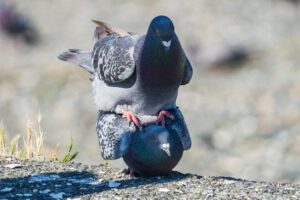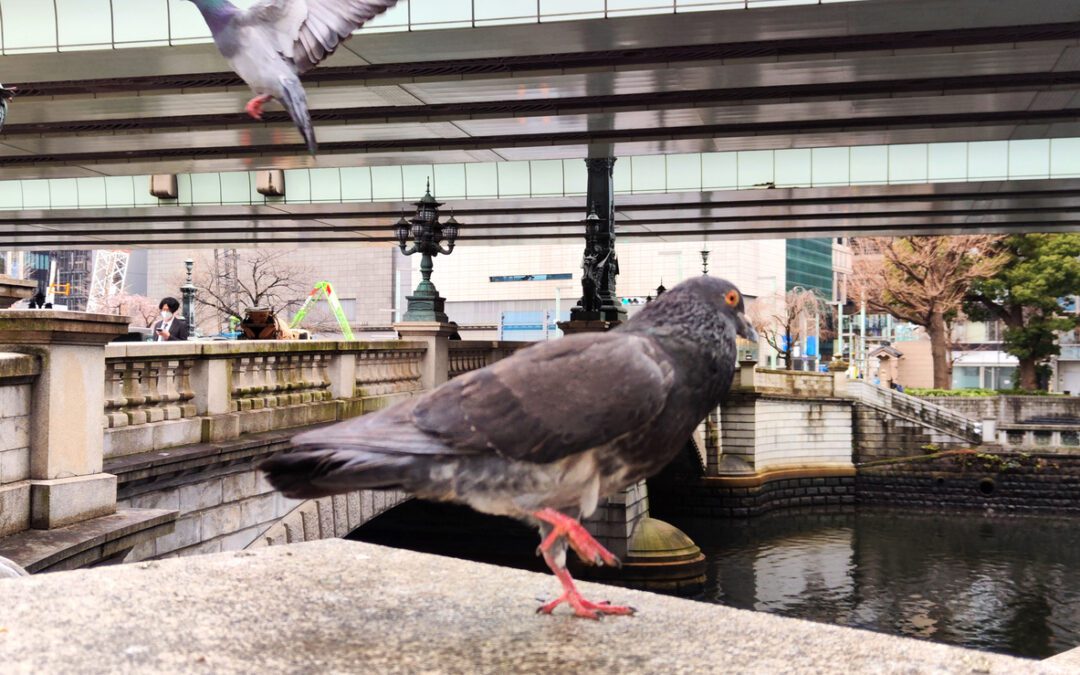From a pigeon’s perspective, city living can’t be beat. Food and water are readily available. Predators are rare. Plus, there’s plenty of free housing. Pigeons find our window ledges, rooftops, bridges, and warehouses to be ideal substitutes for the natural ledges in cliff sides that they have always used as roosting, nesting, and sheltering sites.
When flocks grow too large and become a nuisance, killing the birds is often the first plan of action. But killing pigeons doesn’t work, and there are better, non-lethal ways to fix a pigeon problem.
Three steps to humanely solve a pigeon problem

Pigeons mating and flirting with each other.
You may just need one or a combination of all three techniques, depending on the size of the pigeon population you’re dealing with.
Stop feeding the pigeons (intentionally or not)
Most conflicts with pigeons can be tied at one point or another to feeding, intentionally or otherwise.
Pigeons get fed plenty of handouts and garbage, but there are also well-intentioned pigeon lovers who regularly feed the birds. This does the pigeons more harm than good as the pigeons begin to gather in large numbers, often leading to inhumane and ineffective attempts to reduce their numbers.
When such troubles arise, the best thing for the birds is to reduce feeding gradually over several weeks. The flock will gradually disperse until the remaining number of birds matches what the area can naturally support.
Unintentional food sources
Even when not feeding on purpose, we humans are messy, leaving leftovers and dropped crumbs everywhere. Pigeons hang around town squares, public parks, and other trafficked areas to help themselves to what we leave behind, especially when convenient roosting and nesting sites are nearby. To discourage pigeons from gathering, food attractants need to be cleaned up regularly.
In suburban neighborhoods, too, homeowners may mistakenly feed pigeons or they may be providing food for pigeons inadvertently when feeding their backyard birds by tossing seed on the ground, rather than putting it in birdfeeders. To discourage pigeons visiting your yard, change the type, amount, and timing of feeding. If most of the pigeons fail to move elsewhere, you’ll need to stop feeding all birds for a couple weeks. (Don’t worry; the birds won’t starve.) When you resume feeding, only put out seed in birdfeeders and keep the ground below them cleaned up.
Prevent roosting and nesting
Pigeons look for flat surfaces for roosting and nesting. Encourage them to do these things elsewhere by making flat surfaces unavailable to them. With the correct application of the right product, roosting structures can be rendered virtually pigeon-free.
There are a variety of devices that can be used to change flat nesting spots into inaccessible spaces and prevent pigeons from roosting in areas where they’re not wanted. Attach wood or metal sheathing (Birdslides) at a 45- to 60-degree angle over window ledges and other flat surfaces to keep pigeons from landing.
Install “bird wires” to keep pigeons off ledges, railings, awnings, and rooftops.
Use netting to keep pigeons out of large areas.
NEVER use polybutylene gel. Sticky gel repellents made from polybutene can harm all birds and any animal that comes in contact with it. The HSUS strongly recommends that these dangerous repellents be avoided at all costs. The feathers of any bird who comes into contact with the dense, sticky gel will become damaged, interfering with their ability to fly and to stay water-proofed.
These gel repellents are not selective. Other birds are likely to land on the gel, get stuck, and die a slow death. The polybutene gels are particularly harmful to smaller species.
Limit flock size with pigeon birth control
As year-round nesters, a pair of pigeons can raise a dozen or more young each year. If pigeons have plenty of food and space, their numbers can quickly increase. Fortunately, a bird contraceptive is available that limits growth of pigeon flocks.
Ovocontrol bird food is “birth control” for pigeons. Innolytics, LLC
Known as OvoControl, pigeon contraception comes in the form of a kibble-type food, which causes birds who eat it regularly to lay eggs that fail to develop. In March 2010, OvoControl received landmark general-use approval by the Environmental Protection Agency. Visit ovocontrol.com to learn more about the product and how you can implement an OvoControl program.
Combined with exclusion and other humane measures to discourage roosting and nesting, OvoControl effectively reduces hatching rates in pigeons, thereby limiting flock sizes and diminishing problems associated with large numbers of pigeons.
Business owners who pledge to use OvoControl instead of lethal methods can download our free signage and educational materials. In Hawai’i, where pigeons can be a major problem, businesses that have started OvoControl programs have seen a noticeable decrease in pigeon numbers.
M=====
Pigeon droppings and public health
Disease risk from pigeon droppings is often used to justify killing pigeons, but fresh bird droppings have not been shown to present a health risk.
People may fear that pigeons roosting or nesting nearby, or more specifically the droppings that accompany such sites, are a health threat. These fears usually focus on histoplasmosis, a fungus that grows in dropping-enriched soil, and on diseases caused by Cryptococcus and Salmonella. However, there is little evidence linking pigeons directly to human infections.
Histoplasmosis fungus is common in the eastern and central U.S. As many as 80 % of people tested in these areas prove to have already been exposed to the fungus without knowing.
According to the Centers for Disease Control, fresh bird droppings on surfaces such as sidewalks and windowsills have not been shown to present a health risk. People should avoid contact with any animal droppings, of course, and ordinary good hygiene, such as washing hands and leaving shoes at the door, are adequate prevention if you accidentally come into contact with animal droppings.
Pigeon Patrol
Pigeon Patrol Products & Services is the leading manufacturer and distributor of bird deterrent (control) products in Canada. Pigeon Patrol products have solved pest bird problems in industrial, commercial, and residential settings since 2000, by using safe and humane bird deterrents with only bird and animal -friendly solutions. At Pigeon Patrol, we manufacture and offer a variety of bird deterrents, ranging from Ultra-flex Bird Spikes with UV protection, Bird Netting, 4-S Bird Gel and the best Ultrasonic and audible sound devices on the market today.
Canada’s top wholesaler for bird deterrent products for twelve consecutive years.
Contact us at 1- 877– 4– NO-BIRD, (604) 585-9279 or visit our website at https://www.pigeonpatrol.ca/
Bird Gone, Pigeon Gone, Pigeon problems, pigeon spikes, 1-877-4NO-BIRD, 4-S Gel, Bird Control, Pigeon Control, bird repellent, Bird Spikes, sonic bird repellent, stainless steel bird spikes, bird spikes Vancouver, Ultra Sonic Bird Control, Bird Netting, Plastic Bird Spikes, Canada bird spike deterrents, Pigeon Pests, B Gone Pigeon, Pigeon Patrol, pest controller, pest control operator, pest control technician, Pigeon Control Products, humane pigeon spikes, pigeon deterrents, pigeon traps, Pigeon repellents, Sound & Laser Deterrents, wildlife control, raccoon, skunk, squirrel deterrent, De-Fence Spikes, Dragons Den, Pigeon, Pigeon Patrol, Pigeons Roosting, Vancouver Pigeon Control, Bird Spikes, Bird Control, Bird Deterrent, Pigeon Deterrent, Surrey Pigeon Control, Pest, Seagull deterrent Vancouver Pigeon Blog, Birds Inside Home De-fence, Pigeon Nesting, Bird Droppings, Pigeon Dropping, woodpecker control, Keep The Birds Away, Birds/rats, seagull, pigeon, woodpecker, dove, sparrow, pidgeon control, pidgeon problem, pidgeon control, flying rats, pigeon Problems, bird netting, bird gel, bird spray, bird nails, bird guard, Pigeon control, Bird deterrents, Pigeon deterrents, Bird control, solutions, Pigeon prevention, Pigeon repellent, Bird proofing, Pest bird management, Pigeon spikes, Bird netting, Humane bird control, Bird exclusion, Urban bird control, Anti-roosting devices, Pigeon removal, Bird barriers

